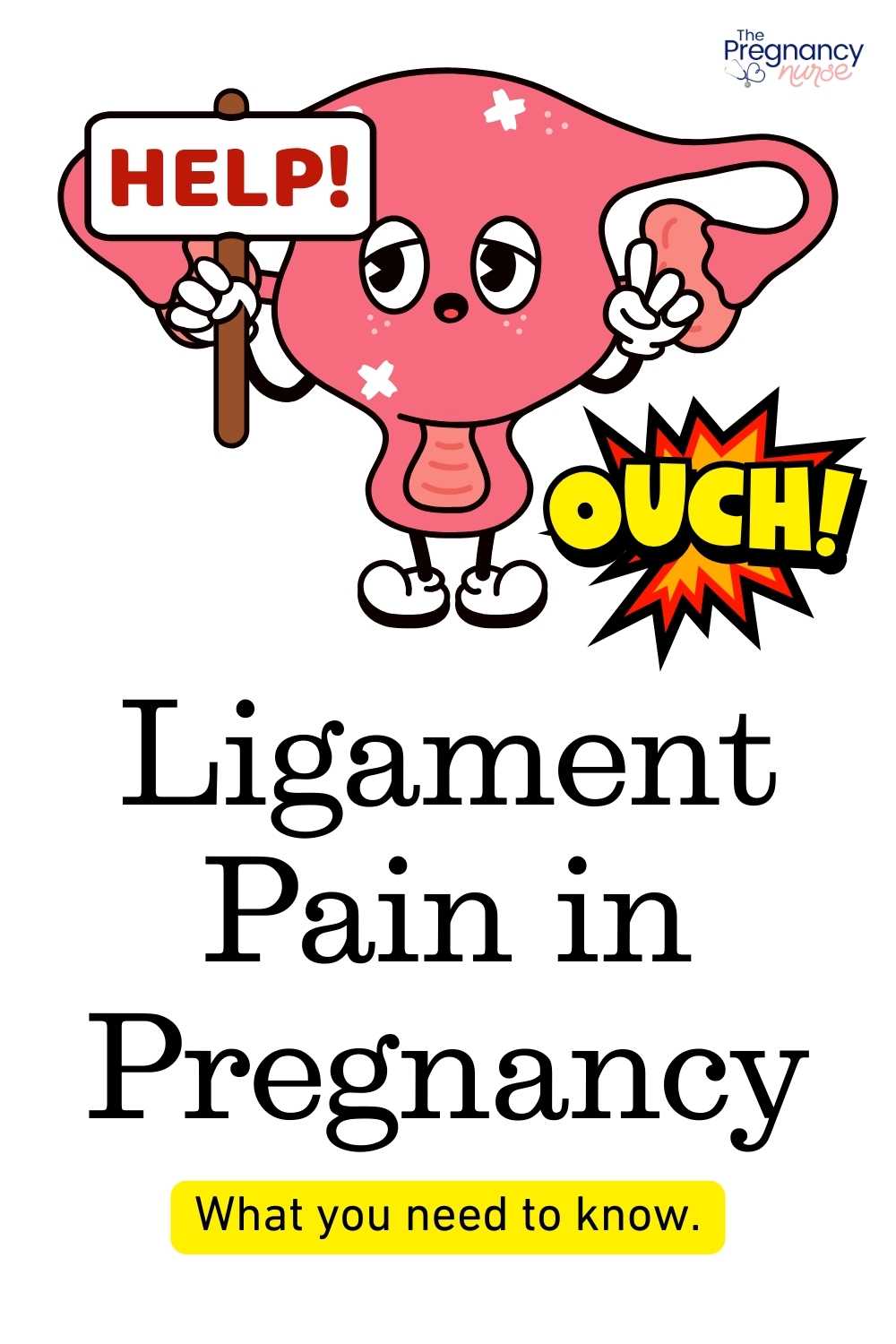Your round ligaments attach your uterus to the rest of your body. During pregnancy they can stretch and feel VERY painful — so, how do you tell THAT pain from everything else? Let’s talk about it!
Before we get started, I know that any new crazy new pregnancy symptom is worth talking to your provider about — so if you have new aches and pains please talk with them. BUT these aren’t uncommon, so I want to explain them a bit more!
What Are the Round Ligaments?

They basically hold your uterus in place. As you can imagine, you can’t have your vital organs just floating all over the place, so ligaments help hold them in place.
The uterus has a few ligaments holding it, but the ones that seem to get the most stretched during pregnancy are the round ligaments. They attach at the sides of the uterus and then fan out and attach to the side walls of the abdomen (so, not quite like the photo, but it’s the best my sweet canva skills could do).
As you can imagine, these ligaments have gone your whole life just holding the uterus in place. Honestly not a real hard job as the organs all sort of shuffle into their own spots and stay there with fat, muscle, and membranes sort of doing most of the job for them.
As the uterus starts to grow that ligament gets STRETCHED like a rubber band and that often translates into pain.
What Does Round Ligament Pain Feel Like?
I want to be clear that it’s not always the round ligaments you’re feeling. This can happen to any of the uterine ligaments. You can see a picture of all the ligaments here. However, I believe that because the round ligaments is on the side, and is normally pretty short it gets the maddest.
Most people describe the pain as sharp. It is often associated with movement like:
- coughing
- sneezing
- laughing
- getting up quickly
In general it’s quick movements that send that pain through you. It can feel like someone is stabbing you. Most often it lasts from a few seconds to a few minutes and then goes away.
Most people feel this on the sides of their belly (where the ligaments attach to their abdomen) or sometimes down into the crotch area.
Isn’t pregnancy magical? I know.
Some people also get pain from their broad ligament and frankly, I’m not really sure how to know which ligament is causing the issue but I do know that it can be VERY painful. Both from patients sharing it with me, and my own personal experience.
How to help pregnancy ligament pain?
The best thing is to try to not do the things that cause the pain in the first place (or assist those ligaments):
- When you cough, sneeze or laugh hold a pillow over your belly to support it
- Take getting up in slow steps so the ligaments have time to adjust.
These ligaments ARE meant to stretch, it’s more the quick movements that catch them off guard and they translate that to pain.
Once you’ve got the pain things to help them relax like heat, relaxing, taking a warm bath can help.
Mostly you need to relax, because the more angry/stressed out you become with them, the tighter your abdomen pulls and just makes them more upset. So, anything you can do to deep breathe and chill out will help.
And yes, learning natural pain management techniques is NOT just for labor pains!

Ligament vs Contraction Pain
Really quick if you’re wondering what the signs of labor are — grab my signs of labor checklist:
So, how do you tell ligament pain from other pains? Well, I’m the first to say that’s tricky.
Ligament pain tends to be described as sharp. Contraction pain isn’t usually described that way — it’s usually more “cramping”, or it builds and dissipates rather than “attacking” you.
Contraction pain normally lasts less than a minute and then goes away for a bit, and then may come back. If the pain is constant, or lasts for like 5 minutes it’s likely not contraction pain.
Ligament pain tends to not be on your uterus, more on the sides/bottom of your abdomen.
But again — if it’s a new pain that is frequent and catching you off-guard you need to talk with your provider about it. If you have ANY concerns that it might be preterm labor please contact your provider right away.
So, that’s ligament pain. I honestly think that heat is one of the best ways to help both me, and the ligaments relax when I feel like I’m being stabbed by my own body. I know it’s miserable, but hopefully knowing what it is, and why it’s happens helps you feel better about it.
Really, a lot of pregnancy is like that. Once you understand it, it’s not as scary (and maybe even hurts less). Labor is going to be just like that. I’d love to help your anxiety about birth. Let me help you feel confident and prepared about your birth in The Online Prenatal Class for Couples. In just a few hours you can get that way! In fact, you can do it WITH a heating pad on your couch…. which sounds way more magical than pregnancy in general!
And, if you’re not quite sure you’re ready for that whole thing, check out the free lesson from it. It’s your first step toward getting in the driver’s seat of your birth.
Did or do you have ligament pain? Tell us in the comments!
And, if you want more on this topic I also have a video:








 Tips To Saying No To Your Provider
Tips To Saying No To Your Provider
